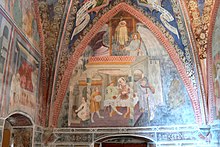Chicken wonder
The so-called chicken wonders of Santo Domingo de la Calzada is closely linked to the Camino de Santiago related legend .
A pilgrim family from Xanten is said to have come to Santo Domingo de la Calzada for the wedding of the pilgrimage to Santiago de Compostela . They stayed in an inn.
The landlady's daughter found the son of the family very attractive, but who - pious and chaste - refused her offer. The affection of the landlady's daughter turned into anger, she thought about revenge and hid a silver cup in his luggage.
The landlord noticed the loss the following day and sent the town bailiffs out, who quickly found what they were looking for. The young man was hung up after a short trial and the parents sadly moved on to Santiago.
On the way back they passed the place of execution again, where they told their son that he was not dead because (Version 1) Santiago and (Version 2) Santo Domingo had held him. The parents then ran to the judge, who was sitting in front of a plate of roasted chickens, and reported what had happened. The judge replied that her son was as dead as the two chickens in front of him, whereupon they rose and fluttered away. Now the son was taken down and the landlord's daughter hung up, the family moved on home.
This legend also exists in many versions beyond the Way of St. James (cf. Barcelos in Portugal; St. Jakob in Kastelaz in Tramin ; St. Jakob in Grissian, municipality of Tesimo , South Tyrol). Artistic references to the miracle can also be found again and again.
literature
- Willi Fährmann: The Chicken Wonder or The Long Way to Santiago . Butzon & Bercker, Kevelaer 2010, ISBN 978-3-7666-1350-9 .
Web links
Individual evidence
- ^ Leo Andergassen: South Tyrol. Art on site. 2nd Edition. Athesia, Bozen 2014, ISBN 978-88-8266-111-3 , p. 68 u. 90.


